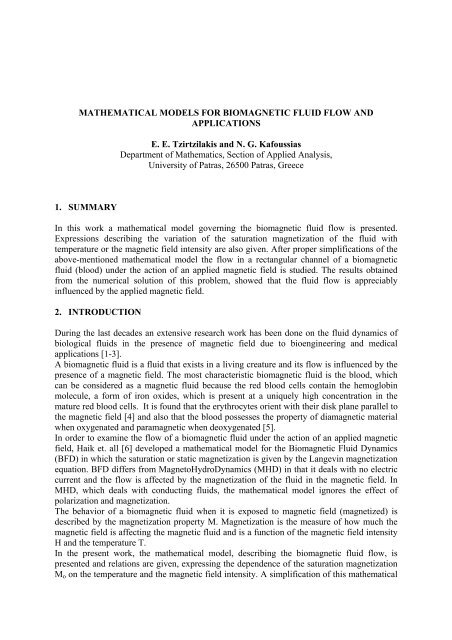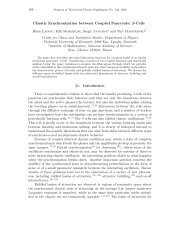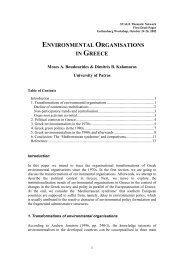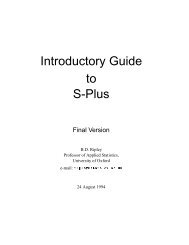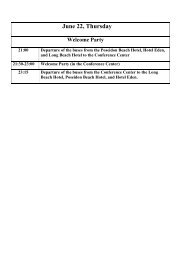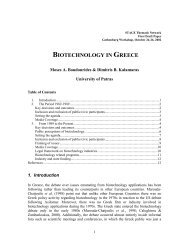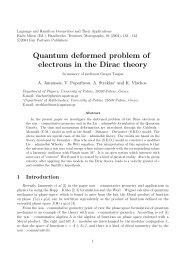mathematical models for biomagnetic fluid flow and applications
mathematical models for biomagnetic fluid flow and applications
mathematical models for biomagnetic fluid flow and applications
Create successful ePaper yourself
Turn your PDF publications into a flip-book with our unique Google optimized e-Paper software.
MATHEMATICAL MODELS FOR BIOMAGNETIC FLUID FLOW AND<br />
APPLICATIONS<br />
E. E. Tzirtzilakis <strong>and</strong> N. G. Kafoussias<br />
Department of Mathematics, Section of Applied Analysis,<br />
University of Patras, 26500 Patras, Greece<br />
1. SUMMARY<br />
In this work a <strong>mathematical</strong> model governing the <strong>biomagnetic</strong> <strong>fluid</strong> <strong>flow</strong> is presented.<br />
Expressions describing the variation of the saturation magnetization of the <strong>fluid</strong> with<br />
temperature or the magnetic field intensity are also given. After proper simplifications of the<br />
above-mentioned <strong>mathematical</strong> model the <strong>flow</strong> in a rectangular channel of a <strong>biomagnetic</strong><br />
<strong>fluid</strong> (blood) under the action of an applied magnetic field is studied. The results obtained<br />
from the numerical solution of this problem, showed that the <strong>fluid</strong> <strong>flow</strong> is appreciably<br />
influenced by the applied magnetic field.<br />
2. INTRODUCTION<br />
During the last decades an extensive research work has been done on the <strong>fluid</strong> dynamics of<br />
biological <strong>fluid</strong>s in the presence of magnetic field due to bioengineering <strong>and</strong> medical<br />
<strong>applications</strong> [1-3].<br />
A <strong>biomagnetic</strong> <strong>fluid</strong> is a <strong>fluid</strong> that exists in a living creature <strong>and</strong> its <strong>flow</strong> is influenced by the<br />
presence of a magnetic field. The most characteristic <strong>biomagnetic</strong> <strong>fluid</strong> is the blood, which<br />
can be considered as a magnetic <strong>fluid</strong> because the red blood cells contain the hemoglobin<br />
molecule, a <strong>for</strong>m of iron oxides, which is present at a uniquely high concentration in the<br />
mature red blood cells. It is found that the erythrocytes orient with their disk plane parallel to<br />
the magnetic field [4] <strong>and</strong> also that the blood possesses the property of diamagnetic material<br />
when oxygenated <strong>and</strong> paramagnetic when deoxygenated [5].<br />
In order to examine the <strong>flow</strong> of a <strong>biomagnetic</strong> <strong>fluid</strong> under the action of an applied magnetic<br />
field, Haik et. all [6] developed a <strong>mathematical</strong> model <strong>for</strong> the Biomagnetic Fluid Dynamics<br />
(BFD) in which the saturation or static magnetization is given by the Langevin magnetization<br />
equation. BFD differs from MagnetoHydroDynamics (MHD) in that it deals with no electric<br />
current <strong>and</strong> the <strong>flow</strong> is affected by the magnetization of the <strong>fluid</strong> in the magnetic field. In<br />
MHD, which deals with conducting <strong>fluid</strong>s, the <strong>mathematical</strong> model ignores the effect of<br />
polarization <strong>and</strong> magnetization.<br />
The behavior of a <strong>biomagnetic</strong> <strong>fluid</strong> when it is exposed to magnetic field (magnetized) is<br />
described by the magnetization property M. Magnetization is the measure of how much the<br />
magnetic field is affecting the magnetic <strong>fluid</strong> <strong>and</strong> is a function of the magnetic field intensity<br />
H <strong>and</strong> the temperature T.<br />
In the present work, the <strong>mathematical</strong> model, describing the <strong>biomagnetic</strong> <strong>fluid</strong> <strong>flow</strong>, is<br />
presented <strong>and</strong> relations are given, expressing the dependence of the saturation magnetization<br />
M o on the temperature <strong>and</strong> the magnetic field intensity. A simplification of this <strong>mathematical</strong>
model is used to obtain numerical solution of the differential equations describing the <strong>fluid</strong><br />
<strong>flow</strong> (blood) in a rectangular channel under the action of a magnetic field. The obtained<br />
numerical results, presented graphically, showed that the <strong>flow</strong> is appreciably influenced by<br />
the magnetic field. These results indicate that application of a magnetic field, in the <strong>flow</strong> of a<br />
<strong>biomagnetic</strong> <strong>fluid</strong>, could be useful <strong>for</strong> medical <strong>and</strong> engineering <strong>applications</strong>.<br />
3. MATHEMATICAL FORMULATION<br />
The <strong>mathematical</strong> model <strong>for</strong> the Biomagnetic Fluid Dynamics is based on the modified<br />
Stokes principles <strong>and</strong> on the assumption that besides the three thermodynamic variables P, ρ<br />
<strong>and</strong> T the <strong>biomagnetic</strong> <strong>fluid</strong> behavior is also a function of magnetization M [6]. Under these<br />
assumptions, the governing equations <strong>for</strong> incompressible <strong>fluid</strong> <strong>flow</strong> are similar to those<br />
derived <strong>for</strong> FerroHydroDynamics (FHD) [7], <strong>and</strong> are given by :<br />
Continuity Equation<br />
<br />
∇⋅ V=<br />
0<br />
(1)<br />
Linear Momentum<br />
<br />
DV <br />
2 2 <br />
ρ =−∇ p+ρ F+η∇ V+ξ( ∇ V+ 2∇×ω ) +µ<br />
o ( M⋅∇ ) H+ ⎡∇× H⎤×<br />
Dt<br />
⎣ ⎦<br />
B (2)<br />
Angular Momentum<br />
<br />
Dω<br />
<br />
2 <br />
ρ I =µ<br />
oM× H+η∇ ′ ω+ 2ξ( ∇× V−2ω )<br />
(3)<br />
Dt<br />
Magnetization<br />
<br />
DM 1 <br />
=ω× M− ⎡M−M<br />
⎤<br />
o<br />
Dt τ ⎣ ⎦<br />
(4)<br />
Maxwell Equations (Amperes law <strong>and</strong> Gauss second law)<br />
<br />
∇× H= J =σ ( V×<br />
B)<br />
(5)<br />
<br />
∇⋅ B=∇⋅ H+ M = 0<br />
( )<br />
Magnetization Equations<br />
These equations describe the dependence of saturation or static magnetization M o<br />
on the<br />
applied magnetic field intensity H <strong>and</strong> temperature T <strong>and</strong> the appropriate expressions are<br />
given below.<br />
In the above equations V <br />
is the velocity field, ρ is the <strong>fluid</strong> density, P is the pressure, F is<br />
the body <strong>for</strong>ce per unit volume, η <strong>and</strong> ξ are the coefficients of dynamical <strong>and</strong> rotational<br />
viscosity, respectively, ω is the angular velocity, µ is the magnetic permeability, M<br />
is the<br />
magnetization, H is the magnetic field intensity, B is the magnetic induction, I is the<br />
moment of inertia, per unit mass, η ′ is the shear spin viscosity, τ is the magnetic relaxation<br />
time, M <br />
is the saturation magnetization <strong>and</strong> σ is the electrical conductivity of the <strong>fluid</strong>.<br />
o<br />
3.1 Equilibrium Flow<br />
The above set of equations is a very complicated system <strong>and</strong> simplifications must be made in<br />
order to solve it <strong>for</strong> a specific problem.<br />
As a first approximation we can consider that bio<strong>fluid</strong>s are poor conductors <strong>and</strong> the induced<br />
current is negligibly small. Thus, unlike MHD, Lorentz <strong>for</strong>ces (the last term in eq.(2)) are<br />
much smaller in comparison to the magnetization <strong>for</strong>ce (the last but one term in eq.(2)). Also,<br />
ο
<strong>for</strong> medium shear rates, like blood <strong>flow</strong> in artery, the diffusion of the spin term is much<br />
smaller than that of the magnetic torque or the exchange between internal <strong>and</strong> external<br />
momentum.<br />
The major simplification however, can take place if we consider that the magnetic <strong>fluid</strong> has<br />
either achieved instantaneous magnetization or time has elapsed beyond the relaxation time,<br />
after the <strong>flow</strong> has exposed to the magnetic field. In this situation the <strong>flow</strong> can be considered<br />
as equilibrium <strong>flow</strong> <strong>and</strong> once the particle reaches saturation magnetization it will not have<br />
addition magnetization even if the magnetic field is further increased. Under the equilibrium<br />
assumption the <strong>fluid</strong> magnetization vector, M , at any given instant is parallel to the vector of<br />
the magnetic field intensity, H , <strong>and</strong> the property of magnetization is determined by the <strong>fluid</strong><br />
temperature, density <strong>and</strong> magnetic field intensity M=M(T,ρ,H). Although the equilibrium<br />
<strong>flow</strong> is an idealization <strong>for</strong> the physical behavior of the <strong>biomagnetic</strong> <strong>fluid</strong>, it provides a good<br />
insight to the <strong>biomagnetic</strong> <strong>fluid</strong> <strong>flow</strong> since the governing equations are much more simpler<br />
than the complete set of equations derived in the previous sections <strong>for</strong> non equilibrium case.<br />
The equations of motion <strong>for</strong> the equilibrium <strong>flow</strong> can be written now as:<br />
Continuity Equation<br />
<br />
∇⋅ V=<br />
0, (6)<br />
Linear Momentum<br />
<br />
DV <br />
2<br />
ρ =−∇ p+ρ F+η∇ V+µ oMo∇H, (7)<br />
Dt<br />
1/2<br />
2 2<br />
where H= ⎡<br />
⎣Hx<br />
+ H ⎤<br />
y⎦<br />
.<br />
3.2 Saturation Magnetization Equations<br />
In equilibrium situation the magnetization property is generally determined by the <strong>fluid</strong><br />
temperature, density <strong>and</strong> magnetic field intensity <strong>and</strong> various equations, describing the<br />
dependence of M o on these quantities, are given in bibliography [6], [7]. The simplest relation<br />
is the linear equation of state, given in [8]:<br />
M = K( T −T), (8)<br />
o<br />
c<br />
where K is a constant called pyromagnetic coefficient <strong>and</strong> T<br />
c<br />
is the Curie temperature.<br />
Above the Curie temperature the bio<strong>fluid</strong> does not subjected to magnetization.<br />
Another equation <strong>for</strong> magnetization, below the Curie temperature is given in [9]<br />
M<br />
c<br />
o<br />
=<br />
1⎜ ⎟<br />
⎝ T1<br />
⎠<br />
)<br />
β<br />
⎛T<br />
− T⎞<br />
M , (9)<br />
where β is the critical exponent <strong>for</strong> the spontaneous or saturation magnetization. For iron<br />
β=0.368, M 1 =54 Oe <strong>and</strong> T 1 =1.45 K.<br />
A linear equation involving the magnetic intensity H <strong>and</strong> temperature T is given in [10]<br />
M = KH T −T<br />
. (10)<br />
o<br />
(<br />
c<br />
Finally, Higashi et. all [4], found that the magnetization process of red blood cells behaves<br />
like the following function, known as Langevin function,<br />
⎡ ⎛µ omH<br />
⎞ κT<br />
⎤<br />
Mo<br />
= mN⎢coth⎜ ⎟− ⎥<br />
⎣ ⎝ κ T ⎠ µ<br />
omH<br />
, (11)<br />
⎦<br />
where m is the particle magnetization, N is the number of particles per unit volume <strong>and</strong> κ the<br />
Boltzman’s constant.<br />
T c
In all the above cases the magnetization M o is dependent on the temperature T of the<br />
<strong>fluid</strong>. In such a case (non-isothermal case), it is also necessary to consider in the<br />
<strong>mathematical</strong> model, describing the problem under consideration, the energy equation<br />
containing the temperature T of the <strong>fluid</strong>. This equation can be written as [8]<br />
DT ∂M<br />
<br />
o<br />
2<br />
ρ Cp<br />
+µ<br />
oT ⎡V⋅( ∇ H) ⎤ = k∇ T+<br />
ηΦ<br />
(12)<br />
Dt ∂T<br />
⎣ ⎦<br />
where k is the coefficient of thermal conductivity of the <strong>fluid</strong>, C p the specific heat <strong>and</strong> Φ the<br />
dissipation function.<br />
4. APPLICATIONS<br />
Biomagnetic <strong>fluid</strong> <strong>flow</strong> in a Channel<br />
As a simple, but representative, application of <strong>biomagnetic</strong> <strong>fluid</strong> <strong>flow</strong> we consider the steady<br />
two-dimensional laminar <strong>flow</strong> of an incompressible viscous <strong>biomagnetic</strong> <strong>fluid</strong> (blood) in a<br />
space between two parallel flat plates (channel). The length of the plates is L <strong>and</strong> the distance<br />
between them is h (h
of the magnetic source the friction coefficient is increased substantially due to the action of<br />
the magnetic field. The contours of the stream function, <strong>for</strong> various magnetic numbers, are<br />
shown in Figures 4-6. The magnet affects the <strong>fluid</strong> <strong>flow</strong> <strong>and</strong> two vortices are created near the<br />
magnetic pole, as the magnetic field strength is increased. The contours of vorticity function<br />
are shown in Figures 7-9 <strong>and</strong> of temperature function in Figures 10-12. Near the pole we<br />
observe a slight increase of the temperature as a result of additional energy from the magnetic<br />
field of the pole. It should be remarked that in the absence of the magnetic field straight lines<br />
represent temperature, stream as well as the vorticity function. Thus, the <strong>for</strong>mation of these<br />
contours is the result of the action of the applied magnetic field on the <strong>flow</strong> field. These<br />
results show that in the presence of the magnetic field, the <strong>flow</strong> field is changing drastically,<br />
<strong>and</strong> especially the skin friction coefficient, which is affected near the area of the magnetic<br />
pole. These conclusions suggest that a careful choice of the imposed magnetic field will<br />
affect the <strong>flow</strong> characteristics <strong>and</strong> hence can be utilized <strong>for</strong> medical <strong>and</strong> engineering<br />
<strong>applications</strong>.<br />
Figure 4. Contours <strong>for</strong> stream function <strong>for</strong> Mn=2000<br />
Figure 5. Contours <strong>for</strong> stream function <strong>for</strong> Mn=4000<br />
Figure 6. Contours <strong>for</strong> stream function <strong>for</strong> Mn=6000<br />
Figure 7. Contours <strong>for</strong> vorticity function <strong>for</strong> Mn=2000<br />
Figure 8. Contours <strong>for</strong> vorticity function <strong>for</strong> Mn=4000<br />
Figure 9. Contours <strong>for</strong> vorticity function <strong>for</strong> Mn=6000
Figure 10. Contours <strong>for</strong> temperature function <strong>for</strong> Mn=2000<br />
Figure 11. Contours <strong>for</strong> temperature function <strong>for</strong> Mn=4000<br />
Figure 12. Contours <strong>for</strong> temperature function <strong>for</strong> Mn=6000<br />
Acknowledgements: The program “K. Karatheodoris” No. 2439 - University of Patras-<br />
Research Committee, financially supported this work.<br />
5. References<br />
[1] Haik, Y., Pai, V. <strong>and</strong> Chen C.J., Development of magnetic device <strong>for</strong> cell separation,<br />
Journal of Magnetism <strong>and</strong> Magnetic Materials, 194,254-261 (1999).<br />
[2] Ruuge, E. K. <strong>and</strong> Rusetski, A.N., Magnetic <strong>fluid</strong> as Drug Carriers: Targeted Transport<br />
of Drugs by a Magnetic Field, Journal of Magnetism <strong>and</strong> Magnetic Materials, 122, 335-<br />
339 (1993).<br />
[3] Plavins, J. <strong>and</strong> Lauva, M., Study of Colloidal Magnetite Binding Erythrocytes:<br />
Prospects <strong>for</strong> Cell Separation, Journal of Magnetism <strong>and</strong> Magnetic Materials, 122, 349-<br />
353 (1993).<br />
[4] Higashi, T., Yamagishi, A., Takeuchi, T., Kawaguchi, N., Sagawa, S., Onishi, S. <strong>and</strong><br />
Date, M., Orientation of Erythrocytes in a strong static magnetic field, J. Blood, 82(4),<br />
1328-1334 (1993).<br />
[5] Pauling, L. <strong>and</strong> Coryell, C. D., The magnetic Properties <strong>and</strong> Structure of Hemoglobin,<br />
Oxyhemoglobin <strong>and</strong> Carbonmonoxy Hemoglobin, Proceedings of the National<br />
Academy of Science, USA, 22, 210-216 (1936).<br />
[6] Haik, Y.,Chen, J.C. <strong>and</strong> Pai V.M., In: Winoto, S.H., Chew Y.T., Development of <strong>biomagnetic</strong><br />
<strong>fluid</strong> dynamics, Proceedings of the IX International Symposium on Transport<br />
Properties in Thermal Fluids Engineering, Singapore, Pacific Center of Thermal Fluid<br />
Engineering, Wijeysundera N.E. (eds.), Hawaii, U.S.A.,121-126 (June 25-28, 1996).<br />
[7] Rosensweig, R.E., Ferrohydrodynamics, Cambridge University Press (1985).<br />
[8] Andersson, H. I. <strong>and</strong> Valnes, O. A., Flow of a heated ferro<strong>fluid</strong> over a stretching sheet<br />
in the presence of a magnetic dipole, Acta Mechanica, 128, 39-47 (1998).<br />
[9] Arrott, A.S., Heinrich, B. <strong>and</strong> Templeton, T.L., Phenomenology of Ferromagnetism: I.<br />
Effects of Magnetostatics on Susceptibility, IEEE Transactions on Magnetics, 25, 4364-<br />
4373 (1989).<br />
[10] Matsuki, H., Yamasawa, K. <strong>and</strong> Murakami, K., Experimental Considerations on a new<br />
Automatic Cooling Device Using Temperature Sensitive Magnetic Fluid, IEEE<br />
Transactions on Magnetics, 13 (5), 1143-1145 (1977).<br />
[11] Mazumdar J.N., Bio<strong>fluid</strong> Mechanics, World Scientific Publishing Co., Singapore<br />
(1992).


